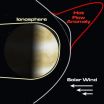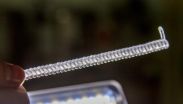(Press-News.org) Epidemiological studies demonstrate that diseases of the central nervous system such as Alzheimer, Parkinson and schizophrenia protect against cancer. The most remarkable example is Alzheimer's disease, which can reduce the risk of suffering from cancer by up to 50%. Various theories have been put forward in an attempt to explain this relationship between diseases at a first glance seem to be so different from the pharmacological, genetic and environmental perspectives. However, the available results were not consistent enough to confirm these models.
Alfonso Valencia, researcher and Vicedirector of Basic Research at the Spanish National Cancer Research Centre (CNIO), today publishes the first evidence of a molecular relationship between cancer and central nervous system diseases in the journal PLOS Genetics. Specifically, the work identifies almost a hundred genes which could explain this relationship.
"We had previously published that several diseases of the brain and nervous system, particularly those which have a neurodegenerative component, are associated with a lower risk of cancer. We refer to this epidemiological evidence as inverse comorbidity," explained Valencia, and added: "In spite of the evidence, we did not have the molecular details which could explain this protective effect, in other words, which genes could be behind this behaviour."
To look further into this paradoxical relationship, the authors of the study used bioinformatic analysis to compare data on the genetic expression of nearly 1,700 people from over 30 studies on diseases in the central nervous system (Alzheimer, Parkinson and schizophrenia) and cancer (colon, lung and prostate cancer)
A 100-GENE SIGNATURE
The results show that almost a hundred genes could be behind the relationship between these diseases: 74 genes which were less active in nervous system diseases were found to be more active in cancer; on the other hand, 19 genes which were more active in nervous system diseases were found to be less active in cancer
"It is precisely these genes which are inversely activated which could explain the lower risk of cancer in patients with nervous system diseases," said the authors of the study.
César Boullosa and Kristina Ibáñez, predoctoral researchers in Valencia's lab, highlighted that "up to 90% of biological processes which appear a greater presence in cancer have a reduced presence in the nervous system diseases analysed."
This data demonstrates that the "global regulation of cell activity could have a protective effect from diseases with inverse comorbidity," concluded the article.
"At the beginning of the project we did not really expect to get statistically significant results, so it was it came as a great surprise to find a clear genetic correlation between these two types of disease," admitted Valencia, who explains that it is "the first time that a molecular relationship between these diseases has systematically been found."
Among the genes identified in the study is PIN1, previously found to be related to both Alzheimer's disease and cancer, as well as genes involved in p53 and Wnt signalling pathways. The study has also identified genes related to crucial biological processes for life such as cell metabolism and communication between cells and their external environment.
DRUG REPOSITIONING
The researchers propose that this genetic association amongst illnesses could open the door to the use of antineoplastic drugs to treat some nervous system diseases, as well as the other way round. One example of this practice is bexarotene, an antineoplastic agent that has already displayed beneficial effects for treating Alzheimer's Disease in mice.
The study represents an example of the new possibilities genomics and bioinformatics can offer in a comprehensive approach to complex diseases such as cancer or nervous system disorders.
INFORMATION:
The study has been conducted in collaboration with the psychiatrist Rafael Tabarés-Seisdedos, from the University of Valencia and the Center for Biomedical Research in Mental Health (CIBERSAM), and computational biologist Anaïs Baudot, from the CNRS in Marseille, France. It has been funded by the Ministry of Economy and Competitiveness and "La Caixa" Foundation.
CNIO team explains lower cancer incidence rate in patients with central nervous system disesase
The results show that almost a hundred genes could explain the relationship between diseases that at first glance seem so different
2014-02-21
ELSE PRESS RELEASES FROM THIS DATE:
NASA researcher finds planet-sized space weather explosions at Venus
2014-02-21
Researchers recently discovered that a common space weather phenomenon on the outskirts of Earth's magnetic bubble, the magnetosphere, has much larger repercussions for Venus. The giant explosions, called hot flow anomalies, can be so large at Venus that they're bigger than the entire planet and they can happen multiple times a day.
"Not only are they gigantic," said Glyn Collinson, a space scientist at NASA's Goddard Space Flight Center in Greenbelt, Md. "But as Venus doesn't have a magnetic field to protect itself, the hot flow anomalies happen right on top of the planet. ...
New apps may help detect seizures, treat strokes
2014-02-20
PHILADELPHIA – Two new smart phone applications may help people detect epileptic seizures and get better stroke treatment, according to two studies released today that will be presented at the American Academy of Neurology's 66th Annual Meeting in Philadelphia, April 26 to May 3, 2014.
In the first study, an epilepsy app was designed to help non-doctors determine if a person is having an epileptic seizure.
"It can often be difficult to determine whether someone is having an epileptic seizure," said study author Victor Patterson, MD, a neurologist from Belfast, UK. ...
Western University primatologist teams with international group to save lemurs
2014-02-20
Lemurs, the most endangered mammal group on Earth, represent more than 20 per cent of the world's primates. Native only to Madagascar, more than 90 percent of the species are threatened with extinction.
A Western University primatologist has teamed with 18 lemur conservationists and researchers, many of whom are from Madagascar or have been working there for decades, to devise an action plan to save Madagascar's 101 lemur species. The action plan contains strategies for 30 different priority sites for lemur conservation and aims to help raise funds for individual projects. ...
Vibration energy the secret to self-powered electronics
2014-02-20
MADISON — A multi-university team of engineers has developed what could be a promising solution for charging smartphone batteries on the go — without the need for an electrical cord.
Incorporated directly into a cell phone housing, the team's nanogenerator could harvest and convert vibration energy from a surface, such as the passenger seat of a moving vehicle, into power for the phone. "We believe this development could be a new solution for creating self-charged personal electronics," says Xudong Wang, an assistant professor of materials science and engineering at the ...
Study in mice raises question: Could PTSD involve immune response to stress?
2014-02-20
COLUMBUS, Ohio – Chronic stress that produces inflammation and anxiety in mice appears to prime their immune systems for a prolonged fight, causing the animals to have an excessive reaction to a single acute stressor weeks later, new research suggests.
After the mice recovered from the effects of chronic stress, a single stressful event 24 days later quickly returned them to a chronically stressed state in biological and behavioral terms. Mice that had not experienced the chronic stress were unaffected by the single acute stressor.
The study further showed that immune ...
Nanoscale pillars could radically improve conversion of heat to electricity
2014-02-20
University of Colorado Boulder scientists have found a creative way to radically improve thermoelectric materials, a finding that could one day lead to the development of improved solar panels, more energy-efficient cooling equipment, and even the creation of new devices that could turn the vast amounts of heat wasted at power plants into more electricity.
The technique—building an array of tiny pillars on top of a sheet of thermoelectric material—represents an entirely new way of attacking a century-old problem, said Mahmoud Hussein, an assistant professor of aerospace ...
Developing countries face 'leading medical scourge of developed countries'
2014-02-20
(Garrison, NY) Chronic illness, already a major and expensive problem in developed countries, is rapidly increasing in developing countries, adding to the longstanding burden caused by high rates of infectious diseases. However, poor countries will not be able to afford the costly medical technologies that wealthy countries use to treat chronic conditions, including heart disease, stroke, cancer, pulmonary disease, and diabetes, writes Daniel Callahan, cofounder of The Hastings Center.
Callahan examines this trend and concludes that it calls for a new, more economically ...
Long-term daily multivitamin supplement use decreases cataract risk in men
2014-02-20
SAN FRANCISCO – Feb. 20, 2014 – Long-term daily multivitamin supplement use may lower cataract risk in men, according to a study of nearly 15,000 male physicians published this month in Ophthalmology, the journal of the American Academy of Ophthalmology.
Past observational studies have indicated a relationship between nutritional supplement use and eye health. However, randomized trial data on the effects of long-term multivitamin supplement use and risk of eye diseases are limited and, in some cases, non-existent. To address this, researchers based at Brigham and Women's ...
Extreme weather decides distribution of insects
2014-02-20
As climate change is progressing, the temperature of our planet increases. This is particularly important for the large group of animals that are cold-blooded (ectothermic), including insects. Their body temperature is ultimately determined by the ambient temperature, and the same therefore applies to the speed and efficiency of their vital biological processes.
But is it changes in average temperature or frequency of extreme temperature conditions that have the greatest impact on species distribution? This was the questions that a group of Danish and Australian researchers ...
UT Dallas-led team makes powerful muscles from fishing line and sewing thread
2014-02-20
An international team led by The University of Texas at Dallas has discovered that ordinary fishing line and sewing thread can be cheaply converted to powerful artificial muscles.
The new muscles can lift a hundred times more weight and generate a hundred times higher mechanical power than the same length and weight of human muscle. Per weight, they can generate 7.1 horsepower per kilogram, about the same mechanical power as a jet engine.
In a paper published Feb. 21 in the journal Science, researchers explain that the powerful muscles are produced by twisting and ...
LAST 30 PRESS RELEASES:
Post-stroke injection protects the brain in preclinical study
Cardiovascular risk score predicts multiple eye diseases
Health: estimated one in ten British adults used or interested in GLP-1 medications for weight loss
Exercise to treat depression yields similar results to therapy
Whooping cough vaccination for pregnant women strengthens babies’ immune system
Dramatic decline in new cases of orphanhood in Uganda driven by HIV treatment and prevention programs
Stopping weight loss drugs linked to weight regain and reversal of heart health markers
Higher intake of food preservatives linked to increased cancer risk
Mass General Brigham–developed cholera vaccine completes phase 1 trial
First experimental validation of a “150-year-old chemical common sense” direct visualization of the molecular structural changes in the ultrafast anthracene [4+4] photocycloaddition reaction
Lack of support for people on weight loss drugs leaves them vulnerable to nutritional deficiencies, say experts
Dogs’ dinners can have greater climate impact than owners’
Are you ready to swap salmon for sprats and sardines?
1.6 million UK adults used weight loss drugs in past year
American College of Cardiology comments on new dietary guidelines for Americans
American Society of Gene & Cell Therapy and Orphan Therapeutics Accelerator partner to advance and commercialize promising rare disease treatments
One in 14 patients having day case surgery have new or worse chronic pain 3 months after their operation
New study highlights link between eviction rates and gun violence
Heatwaves heat up soil but not toxin levels in rice, study finds
Digital modeling reveals where construction carbon emissions really come from
Turning farm waste into water filters
New study shows how the spleen helps the immune system accept a transplant
New Mayo Clinic study advances personalized prostate cancer education with an EHR-integrated AI agent
Researchers identify novel therapeutic target to improve recovery after nerve injury
Microbes in breast milk help populate infant gut microbiomes
Reprogramming immunity to rewrite the story of Type 1 diabetes
New tool narrows the search for ideal material structures
Artificial saliva containing sugarcane protein helps protect the teeth of patients with head and neck cancer
Understanding the role of linear ubiquitination in T-tubule biogenesis
Researchers identify urban atmosphere as primary reservoir of microplastics
[Press-News.org] CNIO team explains lower cancer incidence rate in patients with central nervous system disesaseThe results show that almost a hundred genes could explain the relationship between diseases that at first glance seem so different




